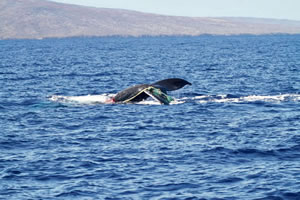Whales Entangled In Fishing Line
It’s a picture we see every winter, but it’s one we could do without: humpback whales fighting for freedom from fishing nets and lines. Marine life rescuers recently found themselves tracking three active entanglement cases at the same time one off Oahu, another in waters near Kaua’i and the third off Maui.“The one off Maui was a very challenging entanglement because there wasn’t a lot of trailing line,” says Jeff Walters, NOAA’s Marine Mammal branch chief and a member of the Large Whale Disentanglement Network. “They (rescuers) weren’t able to hook in a telemetry buoy, and this entanglement was through the mouth. After a while the lines will start digging in and make it difficult to feed.”
The network is a multiagency group made up of members from the Humpback Whale Sanctuary, NOAA Fisheries, the state Department of Land and Natural Resources and the U.S. Coast Guard. Teams are based on all islands, and each one is equipped with the tools to save whales that are in life-threatening situations.
Walters says having three cases at the same time presents some challenges, but he stresses disentanglement efforts should only be done by trained professionals.
“It is dangerous for people who are not trained to get into the water and attempt to disentangle,” says Walters. “There’s a movie right now that features this and we want to stress: That’s the movies! People should not attempt to try this on their own. If that whales dives and you have a wrap around your leg, you’re going down with the whale and you’re not coming back up anytime soon.”
Since the start of the whale season the network has responded to nine separate cases across the Hawaiian Islands, all of which were life-threatening situations. Walters says while that may seem high, it is not uncommon.
“These whales tend to pull gear for weeks, if not months, and so generally they’re not in danger of dying within hours or days,” says Walters. “Usually what we try to do is track them, get in a place where it’s safe for our team to work on them, and generally we attach a tracking buoy that has telemetry on it so we can use satellites to track it. And those buoys actually slow the whale down and tire it, so that it gets more docile and the team can safely get up close to it in an inflatable and cut it loose.”
Despite many success stories, the pictures of an adult whale dragging two orange buoys by its mouth highlights the need for continued protection for these animals. The Hawaiian Islands Humpback Whale National Marine Sanctuary Advisory Council has recommended that the humpback whale sanctuary consider expanding its focus from humpback whales and their habitat to the ecosystem as a whole.
The recommendations include consideration of special management areas and vessel speed limits, as well as increased collaboration with communities and state and federal agencies. They also focus on humans and the environment, rather than managing just one resource or issue.
“NOAA is committed to working with the state of Hawaii to conserve, protect and enhance biodiversity, ecological integrity and cultural legacy of Hawaii’s marine resources,” says Malia Chow, sanctuary superintendent. “We encourage the public to stay involved and continue to participate in shaping the future direction of the sanctuary.”




